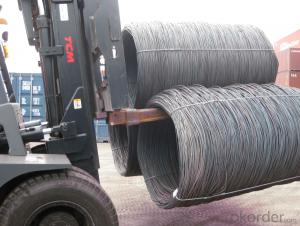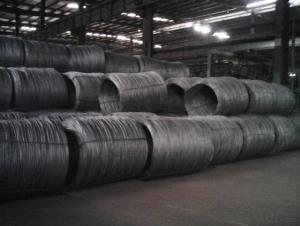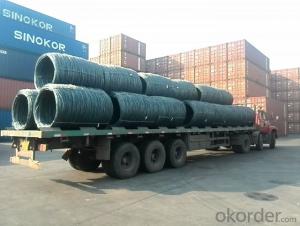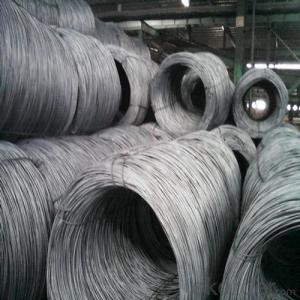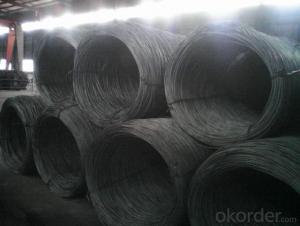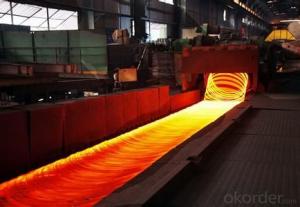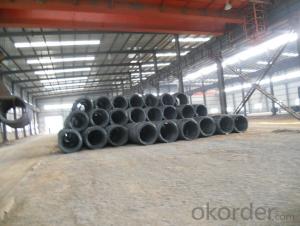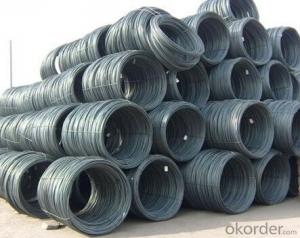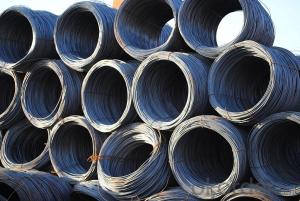Hot Rolled Steel Wire Rod SAE1008 for Making Wire and Nail
- Loading Port:
- Tianjin
- Payment Terms:
- TT or LC
- Min Order Qty:
- 25 m.t.
- Supply Capability:
- 200000 m.t./month
OKorder Service Pledge
OKorder Financial Service
You Might Also Like
Product Description:
OKorder is offering Hot Rolled Steel Wire Rod SAE1008 for Making Wire and Nail at great prices with worldwide shipping. Our supplier is a world-class manufacturer of steel, with our products utilized the world over. OKorder annually supplies products to European, North American and Asian markets. We provide quotations within 24 hours of receiving an inquiry and guarantee competitive prices.
Product Applications:
Hot Rolled Steel Wire Rod SAE1008 for Making Wire and Nail are ideal for structural applications and are widely used in the construction of buildings and bridges, and the manufacturing, petrochemical, and transportation industries.
After hot-rolled the products shaped into coil and delivery as finished product, including round, square, rectangular, hexagonal and so on. Since most of the products are round, it is generally called wire rod. Carbon steel wire rod is widely used in construction and manufacturing. Carbon steel wire rod is mainly used for reinforcement of reinforced concrete and welded structure or reprocessed (roberts , nail, etc.) materials, especially used to produce wire drawing, welding electrode, nails, spring, electronic, precise machinery parts and so on.
Product Advantages:
OKorder's Hot Rolled Steel Wire Rod SAE1008 for Making Wire and Nail are durable, strong, and resist corrosion.
Main Product Features:
· Premium quality
· Prompt delivery & seaworthy packing (30 days after receiving deposit)
· Corrosion resistance
· Can be recycled and reused
· Mill test certification
· Professional Service
· Competitive pricing
Specifications of Hot Rolled Steel Wire Rod SAE1008 for Making Wire and Nail:
Steel Grade: Q195/235, SAE1006-1018B Standard: ASTM, GB
Diameter: 5.5mm, 6.5mm, 7mm,8mm,9mm,10mm,12mm,14mm
Diameter tolerance: ±0.3mm Type: in coil, coil weight around 2MT
Technique: Hot Rolled Place of Origin: China Mainland
Surface: round, no twisted, light and smooth
Chemical Composition: (Please kindly find our chemistry of our material based on Q195、Q235A and Q235B as below for your information)
Trademark | Rank | Chemical composition (quality score) % | |||||
C | Si | Mn | S | P | |||
≤ | ≤ | ≤ | |||||
Q195 | 0.06-0.12 | 0.30 | 0.25 | 0.050 | 0.045 | ||
Q235 | A | 0.14-0.22 | 0.30 | 0.30-0.65 | 0.050 | 0.045 | |
Q235 | B | 0.12-0.20 | 0.30 | 0.30-0.70 | 0.045 | 0.045 | |
Trademark | Rank | Pulling Test | |||||
Bend PointΔs/Mpa | Tensile Strength | Elongation Ratioδ5% | |||||
Thickness (Diameter) /MM | Thickness (Diameter) /MM | ||||||
≤16 | 16-40 | ≤16 | 16-40 | ||||
≥ | ≥ | ||||||
Q195 | 195 | 185 | 315-390 | 33 | 32 | ||
Q235 | A | 235 | 225 | 375-500 | 26 | 25 | |
Q235 | B | 235 | 225 | 375-500 | 26 | 25 | |
Packaging & Delivery of Hot Rolled Steel Wire Rod SAE1008 for Making Wire and Nail:
Packaging Detail: products are packed in coil, each coil weight around 2 MT, and then shipped by container or bulk vessel
Delivery Detail: within 45 days after received deposit or LC.
Label: to be specified by customer, generally, each bundle has 1-2 labels
Trade terms: FOB, CFR, CIF
Carbon Steel Wire Rod on Port

Carbon Steel Wire Rod in Container
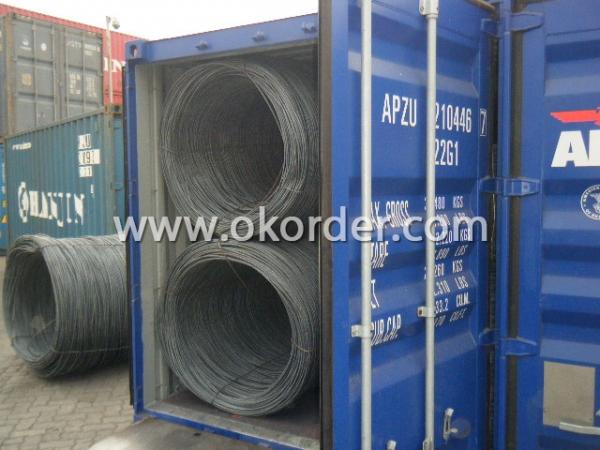
Note:
1. Our products are produced according to national standard (GB), if not, supply according to national standards (GB) or agreement as customer required.
2. Other Grade and Standard carbon steel wire rod we can supply:
Grade:H08A, 30MnSi, 62B-82B
Standard: AISI, BS, JIS, DIN
The Minimum Order Quantity of these products is high, and need to be confirmed.
3. We can not only supply carbon steel wire rod; if you need anything about building materials, please contact us.
4. Please send us your detail specifications when inquire. We will reply to you as soon as possible.We sincerely hope we can establish a long stable business relationship.
FAQ:
Q1: Can fit in the containers of Hot Rolled Steel Wire Rod SAE1008 for Making Wire and Nail?
A2: No problem, we can put them into the containers in the form sideling.
Q3: The products are invoicing on theoritical weight or on actual weight?
A3: We can do it in both manners, according to the customers' request.
Q3: What is the normal tolerance of Hot Rolled Steel Wire Rod SAE1008 for Making Wire and Nail?
A3: Normally 3%-5%, but we can also produce the goods according to the customers' requests.
- Q: How is steel wire rod used in the production of wire mesh for sieving?
- Steel wire rod is a crucial component in the production of wire mesh for sieving. The wire rod is first processed through a series of manufacturing steps to transform it into a suitable material for wire mesh production. This includes drawing the rod through a die to reduce its diameter and increase its length, resulting in a thin and elongated wire. Once the wire rod has been transformed into wire, it is then woven or welded together to create wire mesh. Wire mesh is a grid-like structure with evenly spaced intersecting wires, forming a pattern of uniform openings. This mesh is designed to efficiently filter and separate particles based on their size. In the production of wire mesh for sieving, the steel wire rod is typically used to create the woven wire mesh. The wire is woven together using various weaving techniques, such as plain weave, twill weave, or Dutch weave, depending on the desired mesh characteristics. The wire rod's properties, such as its strength, flexibility, and resistance to corrosion, play a vital role in the quality and durability of the wire mesh. The wire rod's strength ensures that the wire mesh can withstand the tension and stress it may encounter during sieving operations. Additionally, the flexibility of the wire allows the mesh to be easily shaped and manipulated into various sizes and configurations to meet specific sieving requirements. Furthermore, the steel wire rod's resistance to corrosion prevents the wire mesh from deteriorating when exposed to moisture or harsh environmental conditions. This corrosion resistance is particularly important when wire mesh is used in applications where it comes into contact with liquids or substances that could potentially cause damage. Overall, the steel wire rod is an essential material in the production of wire mesh for sieving. Its transformation into wire and subsequent weaving or welding processes enable the creation of durable, reliable, and efficient wire mesh, which is widely used in various industries for sieving and separating particles of different sizes.
- Q: What are the main factors affecting the electrical conductivity of steel wire rod?
- The main factors affecting the electrical conductivity of steel wire rod include the composition and purity of the steel, the presence of impurities or alloying elements, the crystal structure and grain size of the steel, and the temperature at which the conductivity is measured.
- Q: How is steel wire rod used in the manufacturing of wire forms for recreational equipment?
- Steel wire rod is an essential component used in the manufacturing of wire forms for recreational equipment. This type of wire has high tensile strength, durability, and flexibility, making it ideal for creating various wire forms that are commonly found in recreational equipment such as playground structures, sports equipment, and outdoor fixtures. In the production of wire forms for recreational equipment, steel wire rod is initially processed through a series of steps to ensure its quality and desired properties. The wire rod is first drawn through a series of dies to reduce its diameter and increase its length. This process, known as wire drawing, results in a wire that is consistent in size and has improved tensile strength. Once the steel wire rod has been drawn, it can be further manipulated to create different wire forms. For instance, it can be bent, cut, or welded to form intricate shapes that are required for specific recreational equipment. The flexibility of steel wire rod allows for the production of various wire forms, such as loops, hooks, rings, and coils, which are crucial components in different recreational equipment. These wire forms made from steel wire rod are then incorporated into the manufacturing process of recreational equipment. For example, in playground structures, steel wire rod is used to create strong and secure loops or hooks that connect different components together, providing stability and strength to the overall structure. In sports equipment, steel wire rod is often used to form durable and resilient frames for products such as basketball hoops, soccer goals, or fencing materials. Additionally, steel wire rod is used in the manufacturing of wire forms for outdoor fixtures like swings, hammocks, and bike racks. These wire forms are designed to withstand constant usage, exposure to harsh weather conditions, and heavy loads. Steel wire rod ensures that these wire forms are strong, reliable, and long-lasting, ensuring the safety and enjoyment of users. In conclusion, steel wire rod plays a vital role in the manufacturing of wire forms for recreational equipment. Its high tensile strength, durability, and flexibility make it a preferred choice in creating various wire forms that serve as essential components in recreational equipment, providing stability, strength, and safety to users.
- Q: How is steel wire rod used in the manufacturing of piano wire?
- Steel wire rod is used as the primary material in the manufacturing of piano wire. It undergoes a series of processes, including drawing, annealing, and twisting, to create the strong and flexible strands that are then tightly wound together to form piano wire. The high tensile strength and resilience of steel wire rod make it ideal for producing piano wire, which is essential for creating the strings in pianos that produce the desired pitch and sound quality.
- Q: How is steel wire rod used in the production of wire grids?
- Steel wire rod is an essential component in the production of wire grids as it serves as the raw material for manufacturing the individual wires that make up the grid. The wire rod is first drawn through a series of dies to reduce its diameter and increase its length, resulting in a thin, continuous wire. These wires are then woven, welded, or crimped together to create the wire grid, which is commonly used in various applications such as fencing, shelving, and industrial machinery.
- Q: What are the main factors influencing the choice of steel wire rod order lead time?
- The main factors influencing the choice of steel wire rod order lead time include market demand and availability, production capacity, transportation logistics, supplier lead times, and customer preferences.
- Q: What is the global production capacity of steel wire rod?
- The global production capacity of steel wire rod is estimated to be around 160 million metric tons per year.
- Q: How is steel wire rod used in the manufacturing of cables and wires?
- Steel wire rod is an essential component in the manufacturing of cables and wires due to its exceptional strength and durability. It serves as the base material for the production of various types of cables and wires used in a wide range of industries. In the manufacturing process, steel wire rod is first drawn through a series of dies to reduce its diameter and increase its length. This process, known as wire drawing, helps to refine the steel wire rod and improve its mechanical properties. The wire is then subjected to various treatments such as annealing or heat treatment to further enhance its strength and flexibility. Once the steel wire rod has been properly processed, it is ready to be used in the production of cables and wires. The wire is typically coated with materials such as plastic or rubber to provide insulation and protection against moisture, chemicals, and other external factors. This coating also helps to improve the overall performance and longevity of the cables and wires. Steel wire rod is used in the manufacturing of a wide range of cables and wires, including electrical cables, communication cables, and structural cables. Electrical cables, for example, are used to transmit electricity and are commonly found in power grids, buildings, and appliances. Communication cables, on the other hand, are used for data transmission and are widely used in telecommunications and networking systems. In addition to its strength and durability, steel wire rod offers excellent conductivity, making it an ideal choice for applications that require efficient electrical or data transmission. It is also cost-effective compared to other materials, making it a popular choice for cable and wire manufacturers. Overall, steel wire rod plays a crucial role in the manufacturing of cables and wires, providing the strength, durability, and conductivity required for various applications. Its versatility and reliability make it an indispensable component in the production of high-quality cables and wires used in various industries.
- Q: What are the common defects that can occur during the processing of steel wire rod?
- Some common defects that can occur during the processing of steel wire rod are surface cracks, internal voids or inclusions, uneven dimensions, and incorrect chemical composition.
- Q: What are the main factors influencing the choice of steel wire rod coating?
- The main factors influencing the choice of steel wire rod coating include the intended application, environmental conditions, durability requirements, and cost considerations. Firstly, the intended application of the steel wire rod is crucial in determining the appropriate coating. Different coatings provide specific properties such as corrosion resistance, lubricity, or electrical conductivity. For example, if the steel wire rod is intended for outdoor use or exposure to moisture, a corrosion-resistant coating such as zinc or zinc-aluminum is preferred. On the other hand, if the wire rod is used for electrical purposes, a coating with high electrical conductivity may be necessary. Secondly, the environmental conditions in which the steel wire rod will be used also play a significant role in the choice of coating. Factors like temperature, humidity, exposure to chemicals, and UV radiation can impact the performance and durability of the coating. Therefore, coatings that offer excellent resistance to these environmental factors are often selected. Durability requirements are another influential factor. Depending on the intended lifespan of the wire rod and the level of wear and tear it will experience, different coatings with varying levels of durability may be chosen. Some coatings, such as epoxy or polyurethane, provide excellent resistance to abrasion and impact, making them suitable for applications that involve frequent handling or rough environments. Lastly, cost considerations are an important factor in the choice of steel wire rod coating. Different coatings have different price points, and the cost must be balanced with the desired performance and durability. It is essential to choose a coating that meets the requirements at a reasonable cost, ensuring a cost-effective solution without compromising the performance of the wire rod. In conclusion, the choice of steel wire rod coating is influenced by the intended application, environmental conditions, durability requirements, and cost considerations. By considering these factors, manufacturers can select the most suitable coating that provides the necessary properties and durability for the specific application while being cost-effective.
Send your message to us
Hot Rolled Steel Wire Rod SAE1008 for Making Wire and Nail
- Loading Port:
- Tianjin
- Payment Terms:
- TT or LC
- Min Order Qty:
- 25 m.t.
- Supply Capability:
- 200000 m.t./month
OKorder Service Pledge
OKorder Financial Service
Similar products
Hot products
Hot Searches
Related keywords













